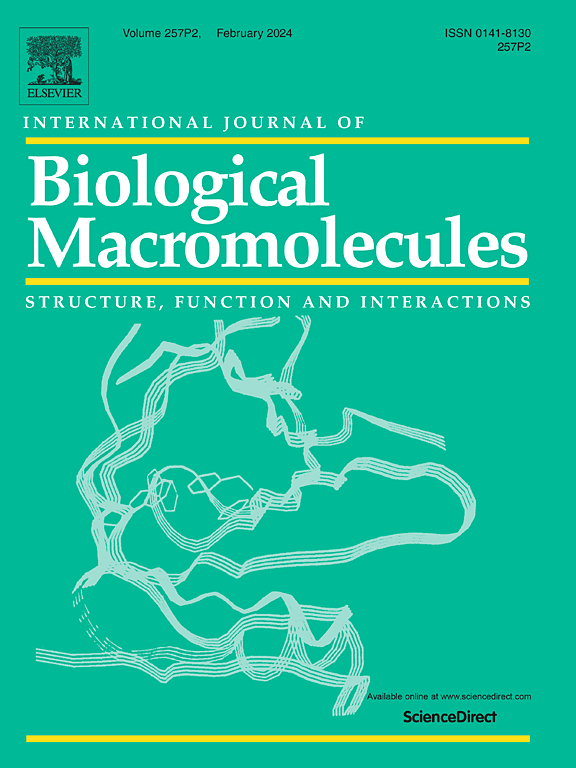Blueberry extract loaded into rice milk/alginate-based hydrogels as pH-sensitive systems to monitor the freshness of minced chicken
IF 8.5
1区 化学
Q1 BIOCHEMISTRY & MOLECULAR BIOLOGY
International Journal of Biological Macromolecules
Pub Date : 2024-11-02
DOI:10.1016/j.ijbiomac.2024.137210
引用次数: 0
Abstract
Hydrogel beads from rice milk and blueberry (BB) skins were fabricated as novel bio-based pH-sensitive devices. The encapsulation of BB into rice milk/alginate beads was achieved through a simple methodology. The colourimetric response of beads in different pH media was evaluated along with the proof of reusability, showing appropriate reversibility. The evaluation of the stability of BB-loaded beads in accelerated ageing conditions (4, 25 and 40 °C and under visible/UV light) showed high stability of beads (up to 28 days) even in the presence of harsh conditions. The half-time of cyanidin-3-glucoside decreases at high temperatures and under UV light exposure. The sensitivity to ammonia (NH3) and trimethylamine (TMA), as main spoilage volatiles of protein food products, was evaluated. The detection limits (LOD) for NH3 and TMA were 22.4 ppm and 72.1 ppm, respectively. Finally, the hydrogel beads were applied to monitor the spoilage of minced chicken breast. The colour of the beads, changing from dark reddish to green/yellowish and indicative of a high level of amine, could be detected by the naked eye after 3–5 days. This research proposes a sustainable, low-cost, and simple method to fabricate BB-loaded hydrogel beads as a promising tool for intelligent packaging applications.
将蓝莓提取物载入米浆/海藻酸盐水凝胶作为 pH 值敏感系统,用于监测碎鸡肉的新鲜度。
以米浆和蓝莓(BB)皮为原料,制备了水凝胶珠,作为新型生物基 pH 敏感器件。通过简单的方法将蓝莓皮封装到米乳/精氨酸珠中。评估了珠子在不同 pH 介质中的比色反应,并证明其可重复使用,显示出适当的可逆性。在加速老化条件(4、25 和 40 °C,以及可见光/紫外线)下对负载 BB 的微珠的稳定性进行了评估,结果表明,即使在苛刻的条件下,微珠也具有很高的稳定性(长达 28 天)。在高温和紫外线照射下,青花素-3-葡萄糖苷的半衰期会缩短。对蛋白质食品的主要腐败挥发物氨(NH3)和三甲胺(TMA)的敏感性进行了评估。NH3 和 TMA 的检测限(LOD)分别为 22.4 ppm 和 72.1 ppm。最后,水凝胶珠被用于监测碎鸡胸肉的腐败情况。3-5 天后,肉眼可检测到珠子的颜色从深红色变为绿色/淡黄色,表明胺含量较高。这项研究提出了一种可持续的、低成本的、简单的方法来制造负载 BB 的水凝胶珠,作为智能包装应用的一种有前途的工具。
本文章由计算机程序翻译,如有差异,请以英文原文为准。
求助全文
约1分钟内获得全文
求助全文
来源期刊
CiteScore
13.70
自引率
9.80%
发文量
2728
审稿时长
64 days
期刊介绍:
The International Journal of Biological Macromolecules is a well-established international journal dedicated to research on the chemical and biological aspects of natural macromolecules. Focusing on proteins, macromolecular carbohydrates, glycoproteins, proteoglycans, lignins, biological poly-acids, and nucleic acids, the journal presents the latest findings in molecular structure, properties, biological activities, interactions, modifications, and functional properties. Papers must offer new and novel insights, encompassing related model systems, structural conformational studies, theoretical developments, and analytical techniques. Each paper is required to primarily focus on at least one named biological macromolecule, reflected in the title, abstract, and text.

 求助内容:
求助内容: 应助结果提醒方式:
应助结果提醒方式:


